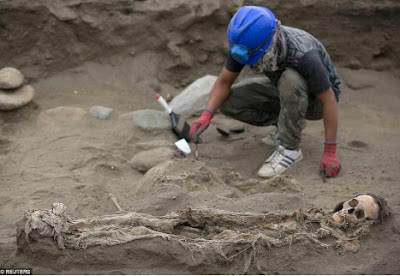It is believed that children, found beside the remains of 30 young old, was killed as part of a ritual to reinforce the devastating rains and floods caused by the El Niño event that devastated a large area around 600 years ago.
The funeral mass is joined by a number of victims of Chimu sites, many involving children, which this year have been exposed in the Huanchaco district of the coastal city of Trujillo in northeastern Peru.

Researcher Dr Gabriel Bélanger Esther Prieto, program director of Huanchaco archaeology, said El Comercio Peru news website: "there is no other place on the planet where there are so many natural burial."
Archaeologists say the discovery series shows Huanchaco ' place of human sacrifice which was unprecedented in the history of the world '.
The children are between six and eight and 11-14 years of age and was buried between the years 1200 and 1 400, but scientists are still determining the exact cause of death.
Small body wrapped in a tissue-some of which are kept aujourd'hui-a shown the body was prepared before death, perhaps as part of a ritual sacrifice, according to Dr. Burmester.
"The evidence suggests that they are the victims," explains Professor John Pervivo, a project researcher, anthropologist at Tula University.
He said that it was never possible to determine the sex of a child or the social class of the Kingdom of the Chimú to which they belong.
"There is no evidence the children were ill, they are healthy, indicating they are middle-class or higher, however, no artifacts, offerings or necklace that shows social differentiation were found, " said.
A total of 30 framework presented on Thursday was found in an area of 2 000 square feet (200 square metres) while the remaining 26 were found in a nearby Tomb.
The researchers said that further investigation would be needed to determine why the children were sacrificed in the Huanchaco, this area only 3 miles (5 km) from the capital, Chan Chan community Chimú.
Carillon is a pre-Inca culture that emerged from the ruins of a civilization that ugly along the coast of Peru in AD900. It's the greatest pre-Columbian Empire in Peru until Inca.
\Agriculture-dominated culture, although they are also known for their wonderful textiles and pottery, the now famous black ceramics and precious metals working in complexity.
It is believed that the carillon Survived by fishing and worship the Moon, believed to be more powerful than the Sun.
Archaeologists believe they are practicing the sacrifice.
Around the year 1470 ad, the ruler of the Inca Tupac Inca Yupanqui conquered the carillon. The Inca is then absorbed many of the practices, including political organizations, irrigation systems and roads engineering.
The short-lived Yupanqui rules, however, that Spain conquered the region in 1534 AD.
















0 komentar:
Posting Komentar